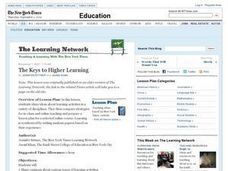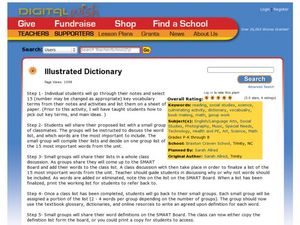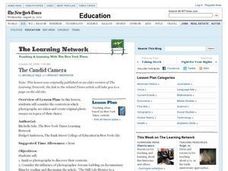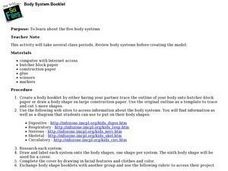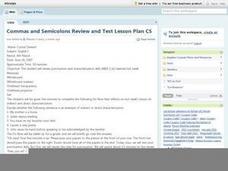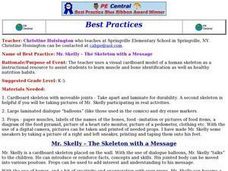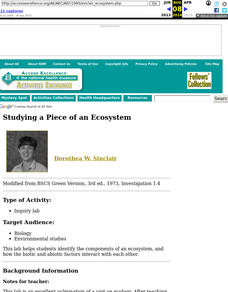Curated OER
The Keys To Higher Learning
Students discuss the validity of using the internet for learning. They compare and contrast the various strategies for learning when done online and in class. Students prepare a lesson plan for an online class and write a paper...
Curated OER
Design Diaries
Students consider their interest in interior design and comment on popular trends. They explore reactions to prolific design ideas that become mundane by reading and discussing the article "Flash in the Can: Designs Soon Forgotten." They...
Curated OER
Using Credit and Spending Money Wisely
Students discuss how to spend money wisely. For this consumer math lesson, students read the book, Mr. Popper's Penguins and discuss how much it costs to take care of a pet. Students complete a worksheet to calculate the total cost of...
Curated OER
Illustrated Dictionary
Young scholars make an illustrated dictionary of words they've used and learned in class. In this vocabulary lesson, students find words from their notes, discuss the words in a group, select the best words as a class, and complete an...
Curated OER
Fractions
Students study fractions. In this art lesson, students fold paper, use origami, making new shapes and discuss the area of the shapes created.
Curated OER
The football and Braking Distance; Model Data with Quadratic Functions
Students use the quadratic formula to solve application problems. The first problem relates to the path of a football thrown from the top of the bleachers. Students compute the time it will take the football to reach certain heights. In...
Curated OER
The Candid Camera
Students examine the influence of photographer Jerome Liebling on documentary films. They read and discuss an article, take photographs, and create an original photo essay and artist statement.
Curated OER
Moonwalking to Mars?
Students examine a quote from George W. Bush's recent speech on space exploration. They evaluate one writer's stance on Bush's space exploration goals by reading and discussing "Plea to Policy Makers: Let's Take Another Giant Step." In...
Curated OER
Making a Body System Booklet
Pupils create a body booklet by having their partner trace the outline of their body onto butcher-block paper.
Curated OER
The Right to Remain Resilient
Students examine the Civil Rights Movements in the U.S., both current and historic. In small groups students investigate a specific civil rights group, create an illustrated timeline, noting key events, people, and state and federal laws.
Curated OER
Zoo visitors look up to new baby
Students, after playing a game of animal 'identity', review and practice key vocabulary words orally and written into their notebooks for this instructional activity. They read a story about a new arrival at the zoo and answer text...
Curated OER
Mathematics Within: Bar And Pie Graphs
Students compare and contrast the use of bar and pie graphs with the same data. They create a data set by surveying all students in the class using sticky notes to make a table on the board. Then, each student creates a bar and pie graph...
Curated OER
What Makes Ten
Students investigate the concept of ten and how it is part of the real number system. They find the quantity of ten using as many combinations as possible. They can count using manipulatives, write on paper, or by doing mental math.
Curated OER
Astronomy: Earth/Moon
Students investigate the Earth and the Moon. They select activities from a menu of options including viewing videos, drawing magnetic fields and plate tectonics, creating vocabulary flashcards, observing the phases of the moon over a...
Curated OER
Language Arts: Punctuation and Characterization
Students prepare for a test on punctuation and characterization by completing practice assignments. While completing the assignment, they note the difference between direct and indirect characterization and explain how punctuation...
Curated OER
United States Presidents
In this presidential worksheet, learners color a picture of a United States President. There are pictures of each president from George Washington through George W. Bush. Each picture takes up one page. The name and dates of service...
Curated OER
Responsibility in Leadership
Students identify ways responsibility is important to productive leadership. In this leadership lesson, students discuss responsibilities of leaders and work in groups to create a list of do's and don'ts for being responsible. Students...
Curated OER
Puberty and Growing Up - a workshop for youth
Students examine the changes that happen to the body during puberty. In this puberty and growing up lesson plan, students describe the basic physical changes that occur to the body during puberty. Students identify the physical changes...
Curated OER
Invisible Invaders
Students research various epidemics that have devastated the world population focusing on the historical events taking place during the times of the epidemics and the epidemics' effects on these societies.
Curated OER
Science: Reading a Compass
Students demonstrate how to take bearings using a compass. In pairs, they select objects in the classroom then write down its first initial and bearing. They exchange papers and try to disciver their partner's object.
Curated OER
So Much To Do, So Little Time
Students explore how people dividde their time among different tasks and the effect that computer technology has had on this practice. Students write their experiences with multitaskinging. They explore how multitasking has affected...
Curated OER
Health: The Skeleton with a Message
Pupils identify human muscles and bones from a cardboard skeleton, named "Mr. Skelly." Using dialog balloons as props, the teacher holds up advice from Mr. Skelly, such as noting he drinks milk to keep his bones strong. The lesson also...
Curated OER
Instant Activity
Sixth graders take dictation and then proofread their work. In this dictation and spelling lesson, 6th graders take dictation and check for mistakes. Students write research notes and proofread for errors.
Curated OER
Studying a Piece of an Ecosystem
Students carry out an outdoor land study in which they identify organisms living in the soil, and any other animals living within the site. Groups also examine abiotic factors. They respond to a series of questions concerning their data...


